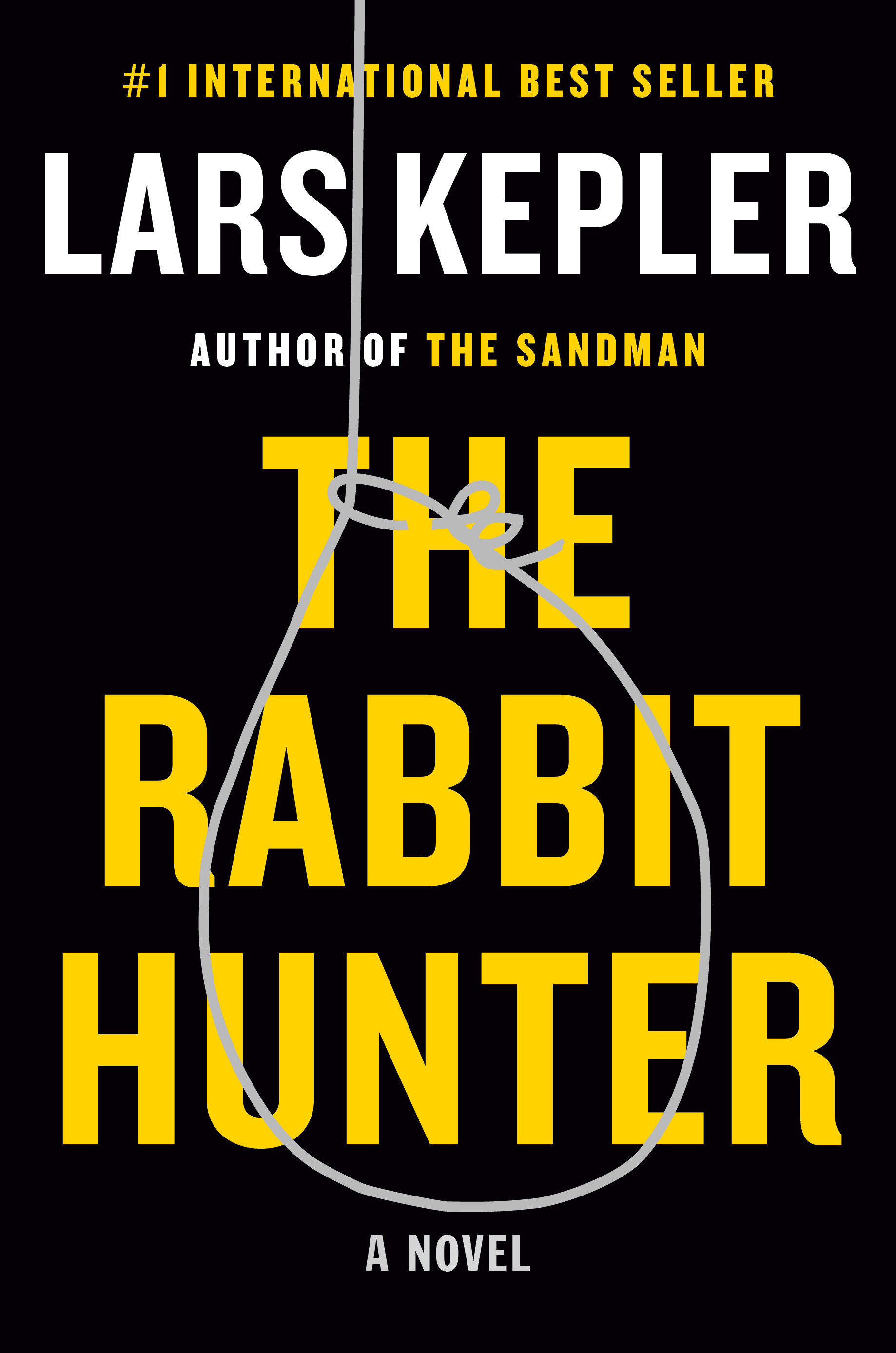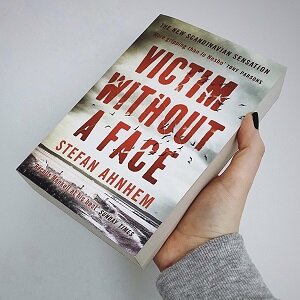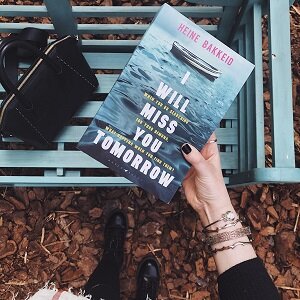Author Q&A: Lars Kepler
THE RABBIT HUNTER
I’ve been a Lars Kepler fan for years now, and a new book by Kepler is always cause for celebration! Today, Kepler’s newest U.S. release THE RABBIT HUNTER hits bookstores, and I’m thrilled to share a Q&A with the authors to celebrate their newest crime novel. Kepler, the pen name for a husband-and-wife writing duo, is known for writing big, intricate, terrifying serial killer thrillers. These books follow a police officer in Stockholm, Sweden, but their real focal points are their villains: psychopaths with well-crafted, totally creepy backstories and motivations, whose shocking crimes seem built for the big screen. THE RABBIT HUNTER is no exception. In THE RABBIT HUNTER, the Stockholm police face off against a twisted killer with a terrifying modus operandi: first, his victims hear a nursery rhyme… and nineteen minutes later on the dot, his victims die.
In what is, for me, an incredible twist of fate, I now work as Kepler’s publicist at their U.S. publisher! I had the absolute pleasure of chatting with Kepler about their newest U.S. release, THE RABBIT HUNTER, and am so excited to share our conversation with CBTB readers today. THE RABBIT HUNTER is the sixth installment in Kepler’s Joona Linna series, but as with every Kepler series installment, it can be read entirely on its own - one of the major perks of this series, I think, is that each installment truly does function as a self-contained thriller. My only word of caution to those readers who might be digging into a Kepler book for the first time: these books are not for the faint of heart.
Read on for more information on THE RABBIT HUNTER, including plot details, early praise, and my conversation with Lars Kepler!
This post contains Amazon Affiliate links. CBTB may earn a small commission for items ordered through these links. All opinions my own.
THE RABBIT HUNTER by Lars Kepler
About the Book:
Ten little rabbits, all dressed in white
Tried to get to heaven on the end of a kite.
Kite string got broken, down they all fell,
Instead of going to heaven, they all went to...
It begins with a nursery rhyme. Nineteen minutes later you die.
A masked stranger stands in the shadows. He watches his victim through the window. He will kill him slowly—make him pay.
Soon the Rabbit Hunter has claimed another three victims. This predator will stop at nothing to reap his ultimate revenge. It’s up to Joona Linna and Saga Bauer to untangle one of the most complex cases of their career, and follow the killer’s trail of destruction back to one horrific night of violence.
Early Praise for THE RABBIT HUNTER:
“Outstanding . . . Kepler has never been better at hiding key clues in plain sight.” —Publishers Weekly (starred review)
“The Rabbit Hunter grips readers from the start and rarely lets up. Although a hefty 500-plus pages, the book unravels at a breakneck pace and almost seems custom-built for a big screen adventure. The Rabbit Hunter is a chase you’ll want to get in on.” —BookPage
“[The Rabbit Hunter] confirms Kepler as a master of disturbing psychological crime novels” —Library Journal
“[The Rabbit Hunter] holds strong appeal for American thriller fans, especially those of Lee Child’s Jack Reacher series.” —Booklist
Author Q&A: Lars Kepler
THE RABBIT HUNTER
Q: The Lars Kepler voice is so seamless, readers new to your work may be surprised to learn that “Kepler” is not actually one person, but rather the pen name for a husband-and-wife writing team! Why was it important for you to create Kepler, a “third author,” in order to write together effectively?
We wrote as two individual authors for many years. Being an author is wonderful, but it’s also one of the loneliest jobs one can have since it’s impossible to let another into the story until it’s done.
One such example is when in 1999, we drove across all of the U.S. in order to do research for the book Alexander was writing. Every day we’d sit next to each other in the car for six hours. The entire time without being able to talk about why we were making this exciting trip. We talked about everything else, of course, but we both knew that what was going on in Alexander’s head at the time had to stay a secret.
We’d been married for 14 years and had three daughters before we even made a first attempt at writing together to escape that solitude. But it isn’t easy to merge two authors’ voices, not even when you love each other. We made quite a few failed attempts that led nowhere (except for to fights, irritation, and deleted documents). We finally realized that we had to let go of our author’s egos. Our method became to invent a third author with a life and habits of his own, and his name was Lars Kepler. As soon as we met him, he guided us into co-writing, and he loved suspense, studied serial killers, and had a style uniquely his own. Ever since meeting Lars, we have an amazing creative flow, and have stopped fighting entirely.
Q: You write every bit of your books together. How exactly does your writing process work?
As you say, we share every part of the writing, from the first idea and its research, to formulating the last sentence.
The foundation of our co-writing is constant conversation. We start by discussing and fleshing out our ideas. We dedicate months to creating the plot itself by filling an entire wall with post-its. Each note describes a scene in the story, and we stand in front of the wall and discuss characters and the course of events. We dream up the story day by day, adding more notes and moving others until we feel like everything’s in place. Then, we sit down at our computers, side by side, and start writing. After a while, we switch texts and try to improve and expand each other’s writing before we switch again. We keep going until we can’t remember who wrote what. At that point, we say that Lars Kepler has taken over, and all that’s left to do is to craft a thriller we would love to read ourselves.
Q: You both have fascinating backgrounds in the arts. Why turn to writing crime fiction? What makes crime fiction a compelling storytelling medium?
We have always read thrillers and crime fiction. We think that what draws us as writers is how the characters are tested in extreme situations. Imagine a couple on the cusp of divorce suddenly realizing that one of them is on a murderer’s kill list. What happens? Will they find their way back to or fail one another?
We love the suspense, the feeling when your heart begins to race. Sometimes we have to get up and walk away from the computers to breathe, calm ourselves. But when it comes down to it, we think crime fiction is so satisfying because it lets you deal with your fears. Our stories are frightening, but the reader – and we – are in essence journeying from chaos to order, from questions to answers, from injustice to justice.
And though thrillers are first and foremost entertainment, the genre is also suitable for discussing serious subjects like existential questions and the failings of society. It holds so much, is able to depict people from all parts of society, and be read by all of them as well, which feels very democratic.
“When it comes down to it, we think crime fiction is so satisfying because it lets you deal with your fears. Our stories are frightening, but the reader – and we – are in essence journeying from chaos to order, from questions to answers, from injustice to justice.” —Lars Kepler
Q: Your newest release, The Rabbit Hunter, finds your protagonist Joona Linna at a very dark moment in his life. Where is Joona when we first meet him in this story?
The Rabbit Hunter starts off with Joona Linna in prison, the result of the events of the previous book, Stalker. He had to help a friend in need, despite knowing what it would cost him.
Now, a strange killer named the Rabbit Hunter has begun to haunt Sweden. The police realize that they will need Joona Linna’s help in order to stop him, and they give Joona an offer he cannot refuse.
All of our books can be read on their own. They always have a new case which will be solved before the ending. But at the same time the books are also connected, forming an epic tale about our protagonists. They journey with us through contemporary society, all the while carrying the scars of what has happened to them in the past, and how that affects them.
Q: The Rabbit Hunter takes readers inside a maximum security prison. What kind of research went into writing this location and its atmosphere authentically?
We always do an incredible amount of research to make the books feel authentic. We try out weapons and close combat, we talk to police and investigators, criminologists and psychiatrists. We study forensic medicine and visit crime scenes, psychiatry wards and prisons.
Before we could start on The Rabbit Hunter, we felt we had to visit Joona in jail in order to see how he was doing. We contacted the director of Kumla prison, the secure facility where all the most dangerous criminals are placed.
Naturally, you can find a lot on Google about high-security prisons, but that’s completely different from actually entering through those gates, passing the lock area, the electric fences and the walls.
We visited the underground culverts that the inmates use to move in small groups between their cells and the mechanical workshop. The slow rhythm and explosive mood are things you have to experience in order to describe. We sat with the security personnel in the control rooms, saw the boredom of the canteen. We walked the courtyard in circles, entered the solitary confinement cells, saw the dirt around the door handles and smelled the stench of loneliness and angst.
Q: Tell us about the nursery rhyme embedded in this story. How did you come up with this deliciously creepy calling card for your story’s villain?
The police name the killer the Rabbit Hunter because all of the victims, just before they die, hear a nursery rhyme about rabbits falling into hell. The rhyme is of course a reference to Agatha Christie’s And Then There Were None. She’s one of the authors who hold a special place in our hearts. We always want to hide a whodunnit within our thrillers. That’s why we give the reader the same information as Joona and Saga receive, so that it’s theoretically possible to solve the case on your own, even before our detectives do.
Q: You are known for writing psychologically complex and genuinely terrifying villains. How do you get inside the head of your books’ killers? Do you have any theories on why so many of us are so fascinated by serial killers?
To us, writing is about making our own fears manageable. We’ve researched a lot about serial killers, talked to psychologists, psychiatrists and other experts, and read almost all the interview books and analyses there are in the field. We never use real killers or cases in our novels since they also have real victims and families. Instead, we take all of the knowledge we’ve gained and mix it with our fears and darkest depths when we create our killers.
Neither we nor Joona believe that some people are born monsters. It’s a long chain of factors and choices that lead there. We empathize with all of our characters, even while we will never excuse murders.
We believe that the fascination with serial killers has its basis in how they defy our most unshakeable morals: life and death are different to them, and yet they’re humans just like we are. That’s what’s so fantastic about fiction. A reader (and a writer) can get close to a serial killer and finally get answers to their questions.
Many thanks to Lars Kepler for taking the time to answer my questions! THE RABBIT HUNTER is now available at your favorite book retailer.
Book Details:
Series: Joona Linna (Book 6)
Hardcover: 528 pages
Publisher: Knopf (January 14, 2020)
Language: English
ISBN-10: 1524732281
ISBN-13: 978-1524732288
Crime by the Book is a participant in the Amazon Services LLC Associates Program, an affiliate advertising program designed to provide a means for sites to earn advertising fees by advertising and linking to Amazon.com. This in no way affects my opinion of the book(s) included in this post.













Nordic Noir fans, listen up: if you’re not already reading the Blix and Ramm series, add it to your to-read pile immediately. Co-written by powerhouse Norwegian crime writers Thomas Enger and Jørn Lier Horst, the Blix and Ramm series merges the best of its authors’ crime writing strengths to deliver a gripping blend of realistic procedural elements and character-driven, emotional suspense. Out last month in e-book and coming soon in paperback, the latest installment, UNHINGED, takes this already-excellent series to the next level. In UNHINGED, protagonists Alexander Blix and Emma Ramm face their most personal case yet when one of their colleagues is targeted in an execution-style killing. UNHINGED pushes this series’ endearing characters to their breaking points in a thrilling plot that is both gripping and deeply heartfelt. I do recommend reading at least this series’ first installment (Death Deserved) before diving into UNHINGED; while the case itself here is stand-alone, much of this story’s impact relies on our connection to its characters, and having a bit of background exposure to them will make readers all the more invested in their fates. Fans of Lars Kepler, Stefan Ahnhem, and Søren Sveistrup won’t want to miss this top-notch Nordic thriller series.